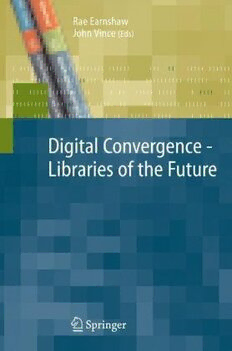Download Digital Convergence - Libraries of the Future PDF Free - Full Version
Download Digital Convergence - Libraries of the Future by Rae Earnshaw, John Vince in PDF format completely FREE. No registration required, no payment needed. Get instant access to this valuable resource on PDFdrive.to!
About Digital Convergence - Libraries of the Future
The convergence of IT, telecommunications, and media is bringing about a revolution in the way information is collected, stored and accessed. There are three principal reasons why this is happening reducing cost, increasing quality, and increasing bandwidth. Moore s Law results in ever-decreasing costs of processing, storage, and transmission. Digital information preserves content accuracy (e.g. digital television) in a way other systems do not. High bandwidth transmission from one place to another on the planet is now possible. Information is ubiquitous and globally accessible, and can be held and accessed just as easily on a global network as on a local personal computer or in a local library. Devices are increasingly intelligent and are network-ready. User interfaces are becoming more adaptable and flexible, and can be tailored to particular application domains. Digital intelligence is becoming seamless and invisible, enabling more attention to be paid to the content and the user s interaction with it. This revolution is having effects on the development and organisation of information and artefact repositories such as libraries, museums, and exhibitions, and the way in which physical and digital aspects are mediated to users. The changes that digital convergence is bringing about are substantial and are also likely to be long-lasting. This volume presents key aspects in this rapidly moving field in the areas of technology and information sciences - from international experts who are leaders in their fields.
Detailed Information
| Author: | Rae Earnshaw, John Vince |
|---|---|
| Publication Year: | 2007 |
| ISBN: | 9781846289033 |
| Pages: | 419 |
| Language: | English |
| File Size: | 3.809 |
| Format: | |
| Price: | FREE |
Safe & Secure Download - No registration required
Why Choose PDFdrive for Your Free Digital Convergence - Libraries of the Future Download?
- 100% Free: No hidden fees or subscriptions required for one book every day.
- No Registration: Immediate access is available without creating accounts for one book every day.
- Safe and Secure: Clean downloads without malware or viruses
- Multiple Formats: PDF, MOBI, Mpub,... optimized for all devices
- Educational Resource: Supporting knowledge sharing and learning
Frequently Asked Questions
Is it really free to download Digital Convergence - Libraries of the Future PDF?
Yes, on https://PDFdrive.to you can download Digital Convergence - Libraries of the Future by Rae Earnshaw, John Vince completely free. We don't require any payment, subscription, or registration to access this PDF file. For 3 books every day.
How can I read Digital Convergence - Libraries of the Future on my mobile device?
After downloading Digital Convergence - Libraries of the Future PDF, you can open it with any PDF reader app on your phone or tablet. We recommend using Adobe Acrobat Reader, Apple Books, or Google Play Books for the best reading experience.
Is this the full version of Digital Convergence - Libraries of the Future?
Yes, this is the complete PDF version of Digital Convergence - Libraries of the Future by Rae Earnshaw, John Vince. You will be able to read the entire content as in the printed version without missing any pages.
Is it legal to download Digital Convergence - Libraries of the Future PDF for free?
https://PDFdrive.to provides links to free educational resources available online. We do not store any files on our servers. Please be aware of copyright laws in your country before downloading.
The materials shared are intended for research, educational, and personal use in accordance with fair use principles.

